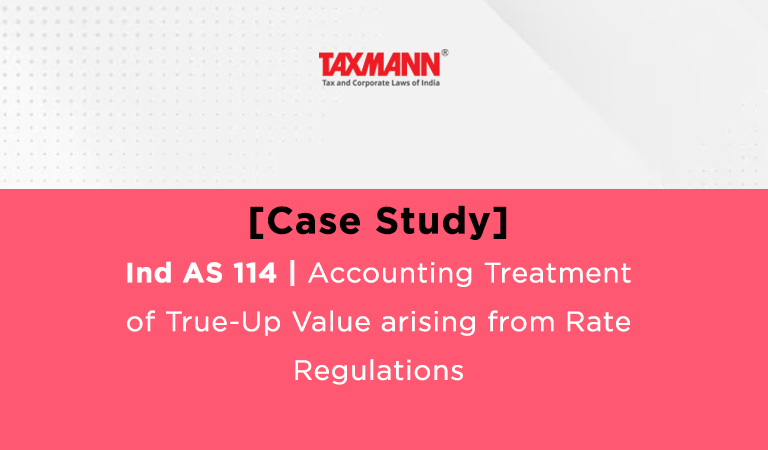[Case Study] Ind AS 114 | Accounting Treatment of True-Up Value arising from Rate Regulations
- Blog|News|Account & Audit|
- 2 Min Read
- By Taxmann
- |
- Last Updated on 21 April, 2023

A company is operating under Rate Regulations for a period of 15 years. However, the regulatory authority fixes the regulatory revenue i.e. Price Cap Regulations in FY 16-17. The same year company started preparing Ind AS financial statements from previous GAAP. The company has not adopted any specific Ind AS and/or Guidance Note for the accounting treatment of regulatory deferral account balances in its financial statements previously. While transitioning to Ind AS, the company has elected not to recognise regulatory deferral accounts in its first Ind AS financial statements also.
However, confusion arises about the treatment of true up (i.e., cash outflows or inflows for over-recovery or under-recovery are spread over the control period through adjustment in revenue rate for the next control period) of Rs. 150 cr. This true-up value has to be adjusted while fixing the revenue rate of the control period. As per current tradition, the company is recognising revenue at the revenue rate determined by the Regulatory Authority for the control period without recognising the amount of true-up. The company sought the opinion of EAC on has to recognise the above-mentioned true-up value of Rs. 150 crores in the books of account.
The Expert Advisory Committee (EAC) of ICAI has noted that Ind AS 114 allows an entity to apply the Standard in its first Ind AS financial statements only if both the conditions of paragraph 5 of Ind AS 114, i.e. (a) it is carrying on rate-regulated activities, and (b) the entity had recognised regulatory deferral account balances in its financial statements as per previous GAAP, i.e., those prepared in accordance with the Guidance Note on Accounting for the Rate Regulated Activities. In case any one of the aforesaid conditions is not met, for instance, the entity had not recognised regulatory deferral account balances in its previous GAAP financial statements, Ind AS 114 is not applicable. Further, even if an entity is within the scope of this Standard, it may elect not to apply this Standard in its first Ind AS financial statements. Since, the company has neither recognised regulatory deferral account balances in its financial statements in accordance with previous GAAP nor elected to recognise regulatory deferral accounts in its first Ind AS financial statements, Ind AS 114 is not applicable to the company for recognition of true-up value adjustments.
Click Here To Read The Full Story
Disclaimer: The content/information published on the website is only for general information of the user and shall not be construed as legal advice. While the Taxmann has exercised reasonable efforts to ensure the veracity of information/content published, Taxmann shall be under no liability in any manner whatsoever for incorrect information, if any.

Taxmann Publications has a dedicated in-house Research & Editorial Team. This team consists of a team of Chartered Accountants, Company Secretaries, and Lawyers. This team works under the guidance and supervision of editor-in-chief Mr Rakesh Bhargava.
The Research and Editorial Team is responsible for developing reliable and accurate content for the readers. The team follows the six-sigma approach to achieve the benchmark of zero error in its publications and research platforms. The team ensures that the following publication guidelines are thoroughly followed while developing the content:
- The statutory material is obtained only from the authorized and reliable sources
- All the latest developments in the judicial and legislative fields are covered
- Prepare the analytical write-ups on current, controversial, and important issues to help the readers to understand the concept and its implications
- Every content published by Taxmann is complete, accurate and lucid
- All evidence-based statements are supported with proper reference to Section, Circular No., Notification No. or citations
- The golden rules of grammar, style and consistency are thoroughly followed
- Font and size that’s easy to read and remain consistent across all imprint and digital publications are applied



 CA | CS | CMA
CA | CS | CMA
